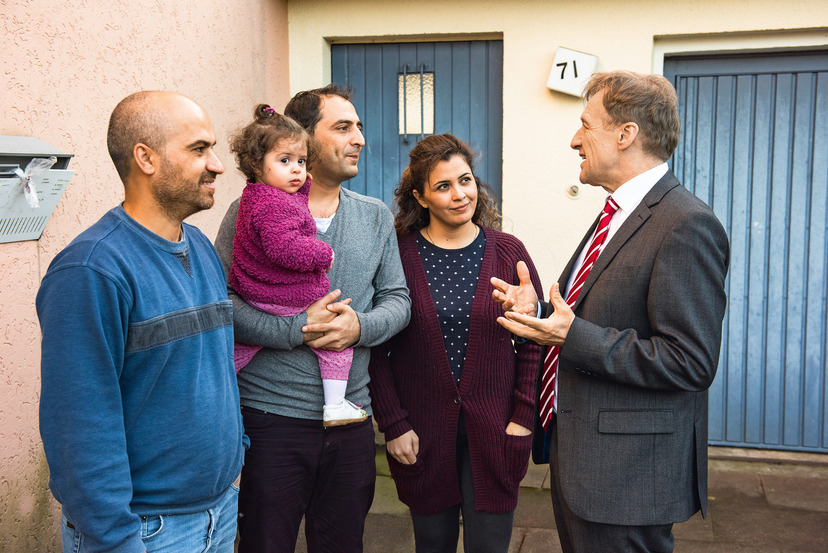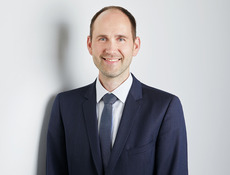Text by Steffi Kammerer for change – the Magazin of the Bertelsmann Stiftung. Issue 1/2016 (shortened version).
![[Translate to English:] Eine fünfköpfige Familie - Eltern und drei Töchter - steht vor ihrem Wohnhaus.](/fileadmin/files/_processed_/f/6/csm_620749186DSC_2151_OPS2_97537240d4.jpg)
Bernd Jonkmanns
With Heart and Mind in Münster
In Münster, a concept for the integration of refugees was already developed 15 years ago. It works, and above all now, it is bearing fruit: good housing throughout the city, and no mass accommodation. But with refugee numbers on the increase, things are getting tight for Münster, too.
About the article
In Münster, a concept for the integration of refugees was already developed 15 years ago. It works, and above all now, it is bearing fruit: good housing throughout the city, and no mass accommodation. But with refugee numbers on the increase, things are getting tight for Münster, too.
Böttcherstraße in Münster, an estate of terraced houses. The entrance has been painstakingly brushed, there are monkey bars in the garden, and flowers are growing in front of the windows. It is hard to believe that more than 13 years ago, these houses once prompted the setting up of citizens' initiatives, excited gatherings and poison-pen letters, even in liberal Münster, a university city. There are six houses, and for more than ten years, they have been home to refugees from all over the world. Now the houses are surrounded by other, very similar terraced houses. Private persons have built their houses here – after the refugees were there, and they are proud of this.
The Sedighis, from Afghanistan, have been living in Böttcherstraße for three-and-a-half years. Their son completed primary school education in Münster, while their daughter, Maryam, not only attends a German higher secondary school but is best pupil in her class as well. She also plays the violin. An old lady in the neighbourhood gave her an instrument as a present. She is now sitting at the kitchen table and learning for an English test the day after tomorrow.
The family have experienced an eventful journey. They got to Greece via Iraq and Turkey, but then they were separated. The father initially stayed behind, while his then 13-year-old son made it on his own to Austria and the mother, in her late stages of pregnancy, travelled to Germany via Italy and France with her daughters and finally arrived in Münster with her new-born baby. Recently, a court approved the Sedighis' application for asylum — the longed-for certainty that they are allowed to stay. At last father Sedighi can work, and he is now employed by a Turkish butcher. Jamila, the mother, has learnt how to write here; in Afghanistan, she was only able to read. Like a story taken from a picture-book.
Above the dustbins there is a sign explaining in all languages what to put where. Inside the house, the walls are painted in different colours, and a calendar is hanging in the common room with the birthday dates of all the children. Forty-eight people live in these houses. The Sedighis' neighbours come from Kosovo, Albania and Pakistan. Two social workers look after them.
The desire for integration
This refugee facility is one of what will soon be 70 that now exist in Münster. Many of them are only temporary. Jochen Köhnke, Head of the Department for Migration and Intercultural Affairs, developed the concept for refugees more than 15 years ago, applying a lot of common sense: "The houses have to be nice to look at," he says. "The neighbours have to get the impression that it is alright for them to be standing there." The alternative at the time would have been mass accommodation surrounded by a tall fence. He grimaces – not acceptable as far as he is concerned.
By and large, Münster has stuck to the plans drawn up in the past, despite fluctuating majorities in the Council. A glance at the draft proposals reveals prosaic lingo as one would expect in an administrative context. Nevertheless, they consistently demonstrate a clear attitude: the desire for integration. And, as Köhnke argued then and still does so today, integration does not come automatically but requires straightforward rules. Not more than 50 people in one facility. Medium-density building. Kindergartens, schools, sports associations that are accessible on foot. And, what is at least as important: intact neighbourhoods. "Urban districts with a major share of socially deprived inhabitants on low income are not suitable for the reception of these facilities," it was already stated in Münster in 2000.
Jochen Köhnke is proud of what they have achieved here. When Pegida had a go in Münster, they were faced by 10,000 counter-protesters. But he is also worried. For even the best concept will not work if one is overwhelmed by developments. And the notions he has require physical space and much time. Both are lacking at the moment.
There are such endless numbers of people; 700 refugees came last October alone. Even more are expected this year. Even though there were only 400 in January, the State of North Rhine-Westphalia has announced that there will be up to 300 refugees a week in peak periods.

Bernd Jonkmanns
Good prospects of being quickly integrated in the labour market. Syrian refugee couple Jwan and Peyman Fatah (second and third from right). At home, he was working as an economist, while she is a civil engineer.
Where can they all be accommodated?
For the first time, Münster will now be deviating from the tried-and-tested rule of not accommodating refugees in lower-class areas. Here, every square metre is hotly contested. Münster is a thriving and constantly growing city that is already bursting at the seams without the refugees.
Around 3,800 refugees are currently living in municipal facilities, says Köhnke. Then 360 refugees are accommodated in regular housing. This adds up to about 4,200 people, each of whom with a story of his or her own. Large numbers of houses are reserved exclusively for single men, others for women travelling on their own, and one for the very sick.
Just where and how a house is built for refugees is a tedious process. Once the decision has been taken, Köhnke and his colleagues will soon visit the location to raise understanding and trust, often two years ahead of the first people arriving. This was also the case with the house in Böttcherstraße, which was then taken over by CVJM. Today, it is one of just under a dozen houses in Münster that are maintained by private agencies
One thing that they have managed in Münster despite the crisis is not to accommodate people in mass facilities. If a prefab house is set up in next-to-no time, like in Gronowskistraße, it will then have room for 100 beds. But it is standing in between family houses in a quiet residential area, and not somewhere on the urban periphery. Jochen Köhnke knows that for the time being, he will have to bid farewell to his notion of a maximum of 50 inhabitants per facility. There is simply too much pressure. "Perhaps we can achieve a figure of 100. But there certainly won't be 1,000 people, like in many another city."
Initial joint steps
Since the summer, the refugees have no longer been initially received at Münster's Social Welfare Office but at Oxford Barracks, which once used to belong to the British. Here, the refugees stay for two to three weeks before they are allocated to the various houses. A taxi is just arriving, and a Bosnian woman is being picked up together with her two little boys. Heavy suitcases disappear in the boot, and half a dozen children wave goodbye to what those who were their friends over the last few days.
Several of the refugees make use of the days they have to wait by taking daily lessons in German. One of the many of the city's volunteers, Birgit, stands in front of the blackboard, explaining the difference between "Du" and "Sie", while grown-up men wearing thick leather jackets are sitting on children’s chairs practising strange vowel mutations. They repeat "Münster" in a chorus. They also learn what a "German house" looks like. Their teacher draws a house with a peaked roof on the blackboard.
There are around 800 volunteers in Münster, and their ranks are growing. "This is also coupled to a certain scale," Köhnke believes. "The reason why we have so many volunteers is that we have small facilities." When he says something like this, he can usually refer to a survey backing, for instance, the claim that the more people there are, the higher the threshold will be to become involved.
Last year, Jochen Köhnke wanted to be elected Lord Mayor of Münster. It didn't work. But this has not frustrated him in his efforts to support the refugees. For the future, he would like to see socially balanced distribution maintained across the entire urban area. His vision for Münster is "that even in larger facilities, we can maintain contact between the population and the refugees. And that we enable fair residence for people." This means in good districts. "Where children are welcome." Where people can perhaps simply get to know their future boss at their next-door neighbour’s barbecue.



